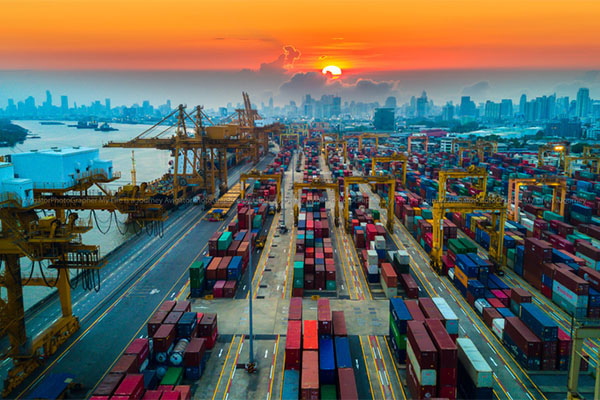Port Tracker report expects import declines over balance of 2022 and into 2023

On the heels of its previous edition, which heralded a new monthly record for United States-bound retail container import volumes, the new edition of the Port Tracker report, which was issued this week by the National Retail Federation (NRF) and maritime consultancy Hackett Associates, is anticipating import activity to “slow significantly” for the remainder of 2022 while still topping 2021 levels.
The ports surveyed in the report include: Los Angeles/Long Beach; Oakland; Tacoma; Seattle; Houston; New York/New Jersey; Hampton Roads; Charleston, and Savannah; Miami; Jacksonville; and Fort Lauderdale, Fla.-based Port Everglades.
Authors of the report explained that cargo import numbers do not correlate directly with retail sales or employment because they count only the number of cargo containers brought into the country, not the value of the merchandise inside them, adding that the amount of merchandise imported provides a rough barometer of retailers’ expectations.
“Retail sales are still growing, but the economy is slowing down and that is reflected in cargo imports,” NRF Vice President for Supply Chain and Customs Policy Jonathan Gold said in a statement. “Lower volumes may help ease congestion at some ports, but others are still seeing backups and global supply chain challenges are far from over. Our biggest concern is the potential for disruption because of separate labor negotiations at the West Coast ports and the freight railroads. Concluding both sets of negotiations without disruption is critical as the important holiday season approaches.”
The report highlighted recent events that have impacted import volumes, including: the July 1 expiration of the International Longshore and Warehouse Union (ILWU), which saw a good number of retailers import earlier than normal and also shift to East and Gulf Coast ports to avoid potential disruptions, with these earlier shipments pacing volumes; freight railroads and their union working with a Presidential Labor Board to settle their differences; and the late-July shutdown of the Port of Oakland related to protests at AB5, a California law focused on eliminating independent owner-operators.
For June, the most recent month for which data is available, import volume—at 2.25 million TEU (Twenty-Foot Equivalent Units)—was down 5.9% compared to May’s 2.4 million TEU. May set a monthly import record, going back to when NRF initially began tracking imports, coming in ahead of the previous record, of 2.34 million TEU, set in March.
For the coming months, Port Tracker issued the following projections:
- July, at 2.26 million TEU, for a 3.2% annual increase;
- August, at 2.2 million TEU, for a 3% annual decrease;
- September, at 2.15 million TEU, for a 0.4% annual increase;
- October, at 2.13 million TEU, for a 3.9% annual decrease;
- November, at 2.06 million TEU, for a 2.7% annual decrease; and
- December, at 2.03 million TEU, for a 3% annual increase
Should these projections come to fruition, the report said that the second half of 2022 would come in at 12.8 million TEU, for a 1.5% annual decrease, with all of 2022 pegged at 26.3 million TEU, for a 2% annual increase.
Hackett Associates Founder Ben Hackett wrote in the report that with the calendar having shifted to the second half of 2022, the run of import growth is receding.
“The outlook is for a decline in volumes compared with 2021 over the next few months, and the decline is expected to deepen in 2023,” wrote Hackett. “As inflation rises, consumers are anticipating further increases in the cost of living for necessities, resulting in less discretionary spending, which will impact the volume of imports. Our forecast projects a downward trend in imports from August through the first half of 2023. Carriers are also reporting less-than-full ships despite high income in the first half of this year.”

Article Topics
3PL News & Resources
XPO opens up three new services acquired through auction of Yellow’s properties and assets FTR’s Trucking Conditions Index weakens, due to fuel price gains LM Podcast Series: Examining the freight railroad and intermodal markets with Tony Hatch Supply Chain Stability Index sees ‘Tremendous Improvement’ in 2023 TD Cowen/AFS Freight presents mixed readings for parcel, LTL, and truckload revenues and rates Descartes March Global Shipping Report highlights ongoing steady volume momentum U.S.-bound import growth track remains promising, notes Port Tracker report More 3PLLatest in Logistics
Warehouse/DC Automation & Technology: Time to gain a competitive advantage The Ultimate WMS Checklist: Find the Perfect Fit Under-21 driver pilot program a bust with fleets as FMCSA seeks changes Diesel back over $4 a gallon; Mideast tensions, other worries cited Four U.S. railroads file challenges against FRA’s two-person crew mandate, says report XPO opens up three new services acquired through auction of Yellow’s properties and assets FTR’s Trucking Conditions Index weakens, due to fuel price gains More LogisticsAbout the Author
Subscribe to Logistics Management Magazine

Find out what the world's most innovative companies are doing to improve productivity in their plants and distribution centers.
Start your FREE subscription today.
April 2023 Logistics Management

Latest Resources














